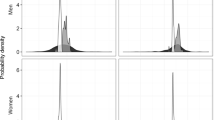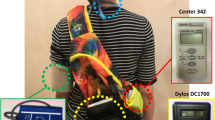Abstract
A longitudinal study investigating personal exposures to PM2.5, nitrogen dioxide (NO2), and carbon monoxide (CO) for cardiac compromised individuals was conducted in Toronto, Canada. The aim of the study was (1) to examine the distribution of exposures to PM2.5, NO2, and CO; and (2) to investigate the relationship between personal exposures and fixed-site ambient measurements of PM2.5, NO2, and CO. In total, 28 subjects with coronary artery disease wore the Rupprecht & Patashnick ChemPass Personal Sampling System one day a week for a maximum of 10 weeks. The mean (SD) personal exposures were 22 μg m−3 (42), 14 p.p.b. (6), and 1.4 p.p.m (0.5) for PM2.5, NO2, and CO, respectively. PM2.5 and CO personal exposures were greater than central fixed-site ambient measurements, while the reverse pattern was observed for NO2. Ambient PM2.5 and NO2 were correlated with personal exposures to PM2.5 and NO2 with median Spearman's correlation coefficients of 0.69 and 0.57, respectively. The correlations between personal exposures and ambient measurements made closest to the subjects' homes or the average of all stations within the study were not stronger than the correlation between personal exposures and central fixed-site measurements. Personal exposures to PM2.5 were correlated with personal exposures to NO2 (median Spearman's correlation coefficient of 0.43). This study suggests that central fixed-site measurements of PM2.5 and NO2 may be treated as surrogates for personal exposures to PM2.5 and NO2 in epidemiological studies, and that NO2 is a potential confounder of PM2.5.
This is a preview of subscription content, access via your institution
Access options
Subscribe to this journal
Receive 6 print issues and online access
$259.00 per year
only $43.17 per issue
Buy this article
- Purchase on Springer Link
- Instant access to full article PDF
Prices may be subject to local taxes which are calculated during checkout



Similar content being viewed by others
References
Ballester F., Tenías J.M., and Perez-Hoyos S. Air pollution and emergency hospital admissions for cardiovascular diseases in Valencia, Spain. J Epidemiol Commun Health 2001: 55: 57–65.
Brauer M., Ebelt S.T., Fisher T.V., Brumm J., Petkau A.J., and Vedal, S. Exposure of chronic obstructive pulmonary disease patients to particles: respiratory and cardiovascular health effects. J Exp Anal Environ Epidemiol 2001: 11 (6): 490–500.
Brook J.R., Dann T., and Bonvalot Y. Observations and interpretations from the Canadian Fine Particle Monitoring Program. J Air Waste Manage Assoc 1999: 49: 35–44.
Burnett R.T., Cakmak S., Brook J.R., and Krewski D. The role of particulate size and chemistry in the association between summertime ambient air pollution and hospitalization for cardiorespiratory diseases. Environ Health Perspect 1997: 105 (6): 614–620.
Burnett R.T., Smith-Doiron M., Stieb D., Cakmak S., and Brook J.R. Effects of particulate and gaseous air pollution on cardiorespiratory hospitalizations. Arch Environ Health 1999: 54: 130–139.
Burnett R.T., Stieb D., Brook J.R., Cakmak S., Dales R., Raizenne M.E., Vincent R., and Dann T. The short-term effects of nitrogen dioxide on mortality in Canadian cities, 2003, in press.
Chang I.-T., Sarnat J.A., Wolfson J.M., Rojas-Bracho L., Suh H.H., and Koutrakis P. Development of a personal multi-pollutant exposure sampler for particulate matter and criteria gases. Pollution Atmospherique 1999: 40: 31–39.
Chock D.P., Winkler S.L., and Chen C. A study of the association between daily mortality and ambient air pollutant concentrations in Pittsburgh, Pennsylvania. J Air Waste Manage Assoc 2000: 50: 1481–1500.
Demokritou P., Kavouras I.G., Ferguson S.T., and Koutrakis P. Development and laboratory performance evaluation of a personal multipollutant sampler for simultaneous measurements of particulate and gaseous pollutants. Aerosol Sci Technol 2001: 35: 741–752.
Ebelt S.T., Petkau A.J., Vedal S., Fisher T.V., and Brauer M. Exposure of chronic obstructive pulmonary disease patients to particulate matter: relationships between personal and ambient air concentrations. J Air Waste Manage Assoc 2000: 50: 1081–1094.
Gamble J.F. PM2.5 and mortality in long-term prospective cohort studies: cause–effect or statistical associations. Environ Health Perspect 1998: 106: 535–549.
Grufferman S. Complexity and the Hawthorne effect in community trials. Epidemiology 1999: 10: 209–210.
Janssen N.A.H., de Hartog J.J., Hoek G., Brunekreef B., Lanki T., Tomonen K.L., and Pekkanen, J. Personal exposure to fine particulate matter in elderly subjects: relation between personal, indoor, and outdoor concentrations. J Air Waste Manage Assoc 2000: 50: 1133–1143.
Katsouyanni K., Touloum G., Spix C., Schwartz J., Balducci F., Medina S., Rossi G., Wojtyniak B., Sunyer J., Bacharova L., Schouten J.P., Ponka A., and Anderson H.R. Short term effects of ambient sulphur dioxide and particulate matter on mortality in 12 European cities: results from time series data from the APHEA project. Br Med J 1997: 314: 1658–1670.
Langan L. Sense-Your-World! With Databear Measurers and Other Langan Instruments. Langan Products, Inc., San Francisco, 1996.
Last J.M. A Dictionary of Epidemiology. Oxford University Press Inc., New York, 2001.
Lee J.-T., Kim H., Hong Y.-C., Kwon H.-J., Schwartz J., and Christiani D.C. Air pollution and daily mortality in seven major cities of Korea, 1991–1997. Environ Res 2000: 84: 247–254.
Lee P.K.H., Brook J.R., Dabek-Zlotorzynska E., and Mabury S.A. Identification of the major sources contributing to PM2.5 observed in Toronto. Environ Sci Technol 2003: 37: 4831–4840.
Leech J.A., Wilby K., McMullen E., and Laporte K. The Canadian human activity pattern survey: report of methods and population surveyed. Chron Dis Can 1996: 17: 118–123.
McGrath J.J. Biological plausibility for carbon monoxide as a copollutant in PM epidemiologic studies. Inhal Toxicol 2000: 12 (Suppl 4): 91–107.
Nyberg F., Gustavsson P., Jarup L., Bellander T., Berglind N., Jakobsson R., and Pershagen G. Urban air pollution and lung cancer in Stockholm. Epidemiology 2000: 11: 487–495.
Occupational Safety and Health Administration. Inorganic methods evaluation protocol, Salt Lake Technical Center, USA, 1999.
Ogawa & Company USA Inc. NO, NO2, NOx and SO2 sampling protocol using the Ogawa Sampler, USA, 1999.
Oglesby L., Kunzli N., Roosli M., Braun-Fahrlander C., Mathys P., Stern W., Jantunen M., and Kousa A. Validity of ambient levels of fine particles as surrogate for personal exposure to outdoor air pollution-results of the European EXPOLIS-EAS Study (Swiss Center Basel). J Air Waste Manage Assoc 2000: 50: 1251–1261.
Ostro B., Lipsett M., Mann J., Braxton-Owens H., and White M. Air pollution and exacerbation of asthma in African-American children in Los Angeles. Epidemiology 2001: 12: 200–208.
Pope C.A.I. Review: Epidemiological basis for particulate air pollution health standards. Aerosol Sci Technol 2000: 32: 4–14.
Pope C.A.I., Hill R.W., and Villegas G.M. Particulate air pollution and daily mortality on Utah's Wasatch Front. Environ Health Perspect 1999: 107: 567–573.
Raaschou-Nielsen O., Hertel O., Thomsen B.L., and Olsen J.H. Air pollution from traffic at the residence of children with Cancer. Am J Epidemiol 2001: 153: 433–443.
Raub J.A., Mathieu-Nolf M., Hampson N.B., and Thom S.R. Carbon monoxide poisoning — a public health perspective. Toxicology 2000: 145: 1–14.
Rodes C., Lawless P.A., Evans J.S., Sheldon L., Williams R.W., Vette A.F., Creason J.P., and Walsh D. The relationship between personal PM exposures for elderly populations and indoor and outdoor concentrations for three retirement center scenario. J Exp Anal Environ Epidemiol 2001: 11: 103–115.
Rojas-Bracho L., Suh H.H., Oyola P., and Koutrakis P. Measurements of children's exposures to particles and nitrogen dioxide in Santiago, Chile. Sci Total Environ 2002: 287 (3): 249–264.
Samet J.M., Dominici F., Curriero F.C., Coursac I., and Zeger S.L. Fine particulate air pollution and mortality in 20 U.S. cities, 1987–1994. N Engl J Med 2000a: 343: 1742–1749.
Samet J.M., Zeger S.L., Dominici F., Curriero F., Coursac I., Dockery D.W., Schwartz J., and Zanobetti A. The National Morbidity, Mortality, and Air Pollution Study. Part II: Morbidity and mortality from air pollution in the United States. Respiratory Report/Health Effects Institute, 2000b, Vol 94, Part 2, pp. 5–70; discussion 71–9.
Samoli E., Touloumi G., Zanobetti A., Le Tertre A., Schindler C., Atkinson R., Vonk J., Rossi G., Saez M., Rabczenko D., Schwartz J., and Katsouyanni K. Investigating the dose–response relation between air pollution and total mortality in the APHEA-2 Multicity Project. Occup Environ Med 2003: 60 (12): 977–982.
Sarnat J.A., Schwartz J., Catalano P.J., and Suh H.H. Gaseous pollutants in particulate matter epidemiology: confounders or surrogates? Environ Health Perspect 2001: 10: 1053–1061.
Vedal S. Ambient particles and health: lines that divide. J Air Waste Manage Assoc 1997: 47: 551–581.
Williams R., Suggs J., Creason J., Rodes C., Lawless P., Kwok R., Zweidinger R., and Sheldon L. The 1998 Baltimore Particulate Matter Epidemiology-Exposure Study: Part 2. Personal exposure assessment associated with an elderly study population. J Exp Anal Environ Epidemiol 2000: 10: 533–543.
Acknowledgements
Funding for this study was provided by the Toxic Substances Research Initiative (Project 101). We acknowledge Mary Rutherford (University of Toronto), Ted Waring (University of Ottawa Heart Institute), Kathy Vandemheen (Ottawa Hospital), Sandy Woodhouse (Environment Canada), Gang Lu (Environment Canada), Rochelle Keogh (Environment Canada) for their assistance in conducting this study, and Bernie Beckerman for producing Figure 1.
Author information
Authors and Affiliations
Corresponding author
Rights and permissions
About this article
Cite this article
Kim, D., Sass-Kortsak, A., Purdham, J. et al. Associations between personal exposures and fixed-site ambient measurements of fine particulate matter, nitrogen dioxide, and carbon monoxide in Toronto, Canada. J Expo Sci Environ Epidemiol 16, 172–183 (2006). https://doi.org/10.1038/sj.jea.7500446
Received:
Accepted:
Published:
Issue Date:
DOI: https://doi.org/10.1038/sj.jea.7500446
Keywords
This article is cited by
-
Relationship between different particle size fractions and all-cause and cause-specific emergency ambulance dispatches
Environmental Health (2020)
-
Impacts of travel activity and urbanicity on exposures to ambient oxides of nitrogen and on exposure disparities
Air Quality, Atmosphere & Health (2015)
-
Monitoring of long-term personal exposure to fine particulate matter (PM2.5)
Air Quality, Atmosphere & Health (2010)
-
Integrated Ambient and Microenvironment Model for Estimation of PM10 Exposures of Children in Annual and Episode Settings
Environmental Modeling & Assessment (2009)
-
On exposure and response relationships for health effects associated with exposure to vehicular traffic
Journal of Exposure Science & Environmental Epidemiology (2008)



